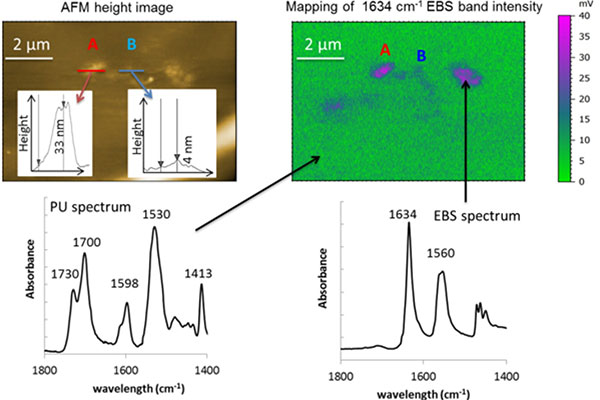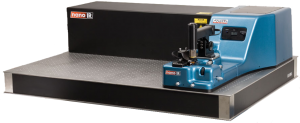Polymer Additives Surface Blooming – AFM-IR Paper
Diagnosing Surface Blooming of Polymer Additives
Additives impart improved performance characteristics in polymer systems such as anti-oxidation, lubrication and UV protection. Surface blooming of additives can alter the bulk and surface properties of the material, leading to a range of undesirable outcomes from mechanical failure to cross contamination. For plastics in medical devices, changes of bio-compatibility or even toxicity are important additional concerns.

AFM-IR combines AFM imaging with infrared spectroscopy
Surface Blooming in Medical Devices
Prof. Johanna Saunier’s research group at Université Paris-Sud published a paper in the International Journal of Pharmaceutics entitled: “Resonance enhanced AFM-IR: A powerful way to characterise blooming on polymers used in medical devices”. They used a new analytical capability of the Anasys Instruments nanoIR™ for characterising surfaces.

Using AFM-IR, high resolution topographic and chemical maps were acquired, which made it possible to identify the chemical nature of very thin deposits observed on the surface. The team selected a polyurethane formulation used for implantable catheters as a model system. They studied the distribution of lubricant additive aggregation with storage conditions. Very thin deposits just 30 to 4 nm thick were identified, by imaging a characteristic infrared absorbance band of the additive. Their size and thickness was measured simultaneously with AFM.
This degree of spatial resolution and sensitivity was achieved using resonance enhanced AFM-IR, which is a new mode of operation developed by Anasys Instruments. This mode is available on both the nanoIR and nanoIR2™ platforms.
Read the full paper from the International Journal of Pharmaceutics (ScienceDirect log-in or purchase required)
About AFM-IR
AFM-IR is delivering insights into nanoscale structure and chemical processes in a wide range of materials, from biomolecules to plastics. Numerous papers have been published illustrating the value of this breakthrough technique.
Combining AFM imaging and infrared spectroscopy delivers a rich set of data:
- AFM reveals nanoscale topography and the mechanical properties of the surface.
- Infrared spectra confirms the chemical identity of nanoscale domains imaged by AFM.
The technique moves infrared microscopy and chemical imaging into a spatial resolution orders of magnitude better than conventional infrared and Raman microscopes, by using an AFM probe tip as an IR absorbance detector.
The flagship system from Anasys Instruments is the nanoIR2, with an infrared epi-illumination configuration (an infrared beam illuminates the top side of the sample), for maximum flexibility in sample preparation. Blue Scientific is the exclusive UK agent for Anasys Instruments, and we are available to advise on the best instrument for your research. For more details or a demonstration, please contact us:


